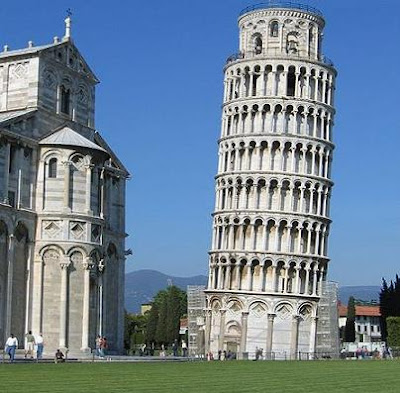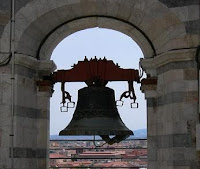The Pisa Tower or Leaning Tower of Pisa or simply the Tower of Pisa is the campanile, or freestanding bell tower, of the cathedral of the Italian city of Pisa. It is also called as Torre pendente di Pisa in Italian language. It is situated behind the Cathedral and is the third oldest structure in Pisa's Cathedral Square after the Cathedral and the Baptistry. Although planned to stand vertically, the tower began leaning to the southeast after the onset of construction in 1173 due to a badly laid foundation and loose substrate that has allowed the foundation to shift direction. The tower currently leans to the southwest.
 The height of the tower is 55.86 m or 183.27 ft from the ground on the lowest side and 56.70 m or 186.02 ft on the highest side. The width of the walls at the base is 4.09 m or 13.42 ft and at the top 2.48 m or 8.14 ft. Its weight is estimated at 14,500 metric tons or 16,000 short tons. The tower has 296 or 294 steps; the seventh floor has two fewer steps on the north-facing staircase. Prior to restoration work performed between 1990 and 2001, the tower leaned at an angle of 5.5 degrees, but the tower now leans at about 3.99 degrees. This means that the top of the tower is 3.9 metres or 12 ft 10 in from where it would stand if the tower were perfectly vertical.
The height of the tower is 55.86 m or 183.27 ft from the ground on the lowest side and 56.70 m or 186.02 ft on the highest side. The width of the walls at the base is 4.09 m or 13.42 ft and at the top 2.48 m or 8.14 ft. Its weight is estimated at 14,500 metric tons or 16,000 short tons. The tower has 296 or 294 steps; the seventh floor has two fewer steps on the north-facing staircase. Prior to restoration work performed between 1990 and 2001, the tower leaned at an angle of 5.5 degrees, but the tower now leans at about 3.99 degrees. This means that the top of the tower is 3.9 metres or 12 ft 10 in from where it would stand if the tower were perfectly vertical.The Tower of Pisa was a work of art, performed in three stages over a period of about 177 years. Construction of the first floor of the white marble campanile began on August 9, 1173, a period of military success and prosperity. The tower began to sink after construction had progressed to the third floor in 1178. This was due to a mere three-meter foundation, set in weak, unstable subsoil, a design that was flawed from the beginning. Construction was subsequently halted for almost a century, because the Pisans were almost continually engaged in battles with Genoa, Lucca and Florence. In 1198, clocks were temporarily installed on the third floor of the unfinished construction.
In 1272, construction resumed under Giovanni di Simone, architect of the Camposanto. In an effort to compensate for the tilt, the engineers built upper floors with one side taller than the other. This made the tower begin to lean in the other direction. Because of this, the tower is actually curved. Construction was halted again in 1284, when the Pisans were defeated by the Genoans in the Battle of Meloria.The seventh floor was completed in 1319. The bell-chamber was not finally added until 1372. It was built by Tommaso di Andrea Pisano, who succeeded in harmonizing the Gothic elements of the bell-chamber with the Romanesque style of the tower. There are seven bells, one for each note of the musical major scale. The largest one was installed in 1655.
Galileo Galilei is said to have dropped two cannon balls of different masses from the tower to demonstrate that their speed of descent was independent of their mass. This is considered an apocryphal tale, its only source being however Galileo's secretary. During World War II, the Allies discovered that the Nazis were using it as an observation post. A U.S. Army sergeant was briefly entrusted with the fate of the tower and his decision not to call in an artillery strike saved the tower from destruction.
On February 27, 1964, the government of Italy requested aid in preventing the tower from toppling. It was, however, considered important to retain the current tilt, due to the vital role that this element played in promoting the tourism industry of Pisa. A multinational task force of engineers, mathematicians and historians was assigned and met on the Azores islands to discuss stabilization methods. It was found that the tilt was increasing in combination with the softer foundations on the lower side. Many methods were proposed to stabilize the tower, including the addition of 800 metric tonnes of lead counterweights to the raised end of the base.

 In 1987, the tower was declared as part of the Piazza del Duomo UNESCO World Heritage Site along with the neighbouring cathedral, baptistery and cemetery. On January 7, 1990, after over two decades of work on the subject, the tower was closed to the public. While the tower was closed, the bells were removed to relieve some weight, and cables were cinched around the third level and anchored several hundred meters away. The final solution to prevent the collapse of the tower was to slightly straighten the tower to a safer angle, by removing 38 cubic metres 50 cu yd of soil from underneath the raised end. The tower was straightened by 18 inches or 45 centimetres, returning to position that it occupied in 1838. The tower was reopened to the public on December 15, 2001, and has been declared stable for at least another 300 years.
In 1987, the tower was declared as part of the Piazza del Duomo UNESCO World Heritage Site along with the neighbouring cathedral, baptistery and cemetery. On January 7, 1990, after over two decades of work on the subject, the tower was closed to the public. While the tower was closed, the bells were removed to relieve some weight, and cables were cinched around the third level and anchored several hundred meters away. The final solution to prevent the collapse of the tower was to slightly straighten the tower to a safer angle, by removing 38 cubic metres 50 cu yd of soil from underneath the raised end. The tower was straightened by 18 inches or 45 centimetres, returning to position that it occupied in 1838. The tower was reopened to the public on December 15, 2001, and has been declared stable for at least another 300 years.In May 2008, after the removal of another 70 metric tons or 77 short tons of earth, engineers announced that the Tower had been stabilized such that it had stopped moving for the first time in its history. They stated it would be stable for at least 200 years. Two German churches have challenged the towers status as the world's most lop sided building the 15th century square Leaning Tower of Suurhusen and the 14th century bell tower in the town of Bad Frankenhausen. Guinness World Records measured the Pisa and Suurhusen towers, finding the former's tilt to be 3.97 degrees.
Post Title
→Pisa Tower
Post URL
→http://guidice-galleries.blogspot.com/2010/02/pisa-tower.html
Visit guidice galleries for Daily Updated Wedding Dresses Collection








